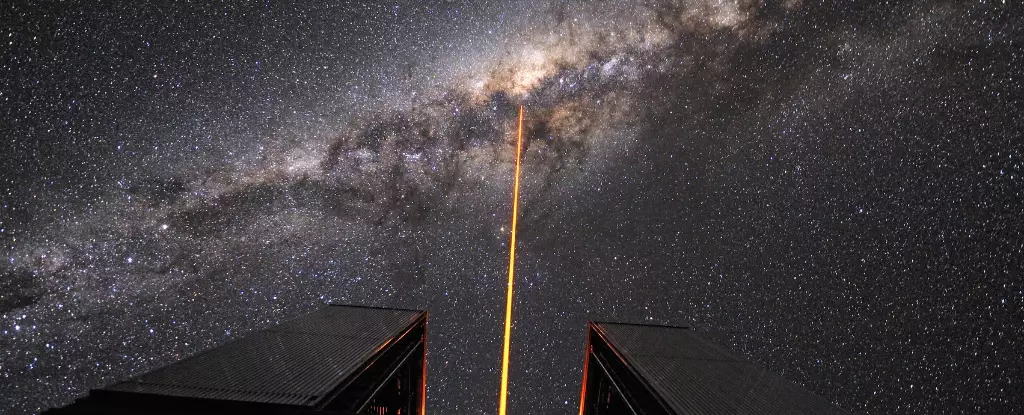At the heart of our Milky Way galaxy lies a supermassive black hole known as Sagittarius A*. This enigmatic entity is approximately 27,000 light-years from our planet, boasting a colossal diameter of about 23.5 million kilometers. The existence of Sagittarius A* has long captivated scientists, offering a potent realm to study the physical laws governing our universe. Recently, a groundbreaking discovery has emerged from this arena, signaling a significant advancement in our comprehension of binary star systems and the dynamics at play around black holes.
A team of astronomers, led by Florian Peißker from the University of Cologne, has triumphantly pinpointed a binary star system in close orbit around Sagittarius A*. This marks a historic revelation, as it establishes the first detection of a binary star system directly circling a supermassive black hole. The implications of this discovery extend beyond mere observation; they provide critical insights into several longstanding astronomical mysteries, particularly the phenomenon of hypervelocity stars.
Binary star systems consist of two stars that orbit one another, by contrast to our solitary Sun, which traverses space alone. Studies suggest that approximately two-thirds of the stars in our galaxy exist as single entities, while the rest are part of binary or multiple star systems. Larger stars tend to be more frequently paired, creating a fertile ground for analysis and understanding within the astrophysical community.
The significance of binary star systems lies in their ability to reveal detailed insights into stellar masses and their respective distances. Unlike single stars, which astronomers often rely on brightness to ascertain their mass, binaries allow for more direct calculations based on the dynamics of their orbits. This wealth of information is crucial, especially in spaces as complex as those surrounding supermassive black holes.
The recent findings suggest that the identified binary system is roughly 2.7 million years old. This timeline implies that the stars likely formed elsewhere in the galaxy before traversing into the vicinity of Sagittarius A*. Their longevity contradicts the notion that proximity to a black hole would result in rapid disruption or annihilation, thus aiding scientists in elucidating the black hole’s capabilities in interacting with nearby celestial bodies.
To visualize the interactions within this binary star system, one can draw parallels to the Moon-Earth-Sun configuration. Just as the gravitational forces result in stable orbits and interactions among these three celestial bodies, the binary star system exhibits intricate dynamics governed by the gravitational pull of Sagittarius A*. This gravitational attraction can produce complex orbital patterns, leading to a significant arcade of interactions akin to the scenarios depicted in the popular scientific narrative of “The Three Body Problem.”
In both contexts, the gravitational interplay can give rise to instability, potentially ejecting celestial bodies from their previously stable configurations. Understanding this mechanism has broader implications in explaining hypervelocity stars, which are stars racing across the cosmic expanse at astounding speeds often exceeding 1,000 kilometers per second.
Hypervelocity stars, a class of stars manifesting these extraordinary speeds, have perplexed astronomers for over a decade. The current hypothesis posits that many of these stars originated in binary systems orbiting supermassive black holes. Following gravitational encounters, one star may be expelled at high velocities, transforming into a hypervelocity star racing towards the outskirts of the galaxy. Observational data supporting this theory is critical as it enhances our understanding of the energetic processes that lead to such stellar phenomena.
Remarkably, some hypervelocity stars appear to be moving away from the galactic center, aligning with predictions that they were once part of a binary system influenced by the dynamics of Sagittarius A*. The burgeoning evidence around this phenomenon solidifies the importance of continued observation and study of binary star systems in our celestial neighborhood.
The detection of a binary star system orbiting Sagittarius A* marks an exciting turning point in galactic studies, supplementing existing theories about stellar dynamics and cosmic evolution. This breakthrough broadens our understanding of the nature of supermassive black holes, their gravitational influence, and the intricate behaviors of stars in their vicinity. As astronomers delve deeper into this realm, the wealth of information that binary star systems can provide will play an essential role in unraveling the mysteries of our universe. The quest for knowledge is far from over; as we gaze into the night sky, the possibilities of new discoveries beckon us forward.

